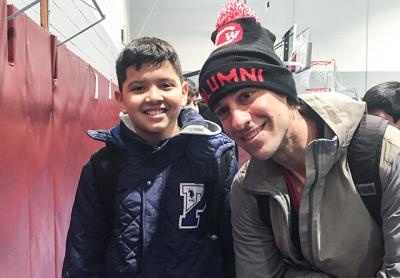Out of the Office and Onto the Rug at John Marshall

As the John M. Marshall Elementary School principal, Beth Doyle is around kids all day long, greeting them in the hallway, popping into classrooms, and joining in all sorts of school activities, but “the longer you’re in administration, the less connected you can feel,” she said on Friday, reflecting on what she learned by spending a day as a first grader.
Ms. Doyle and Russell Morgan, the school’s assistant principal, took part in the Shadow a Student Challenge last month, hoping that by seeing the school through students’ eyes, they might identify ways to improve the John Marshall experience.
Ms. Doyle spent the day shadowing Juliette Jimenez in Joanne Goerler and Laura Rosner’s class. Mr. Morgan was paired with Mike Luque, a fifth grader in Jeff Tupper and Linda Cameron’s class. Rather than observe the classrooms, as they do in their everyday roles, on their shadowing day they put away their dress shoes, took off their administrative hats, and immersed themselves in student life. What parts of the day were the most fun? The most tedious? What kinds of activities were they most engaged in? What did they wish there was time for?
“We sit on the floor a lot,” Ms. Doyle wrote after her day with Juliette, and “it’s jam-packed.” Teachers at John Marshall can have 24 students or more in a classroom. During her day in first grade, Ms. Doyle sat right alongside them on the rug, took part in the same lessons and games, and ate lunch with them, too. Mr. Morgan even went to a viola lesson with his student before the start of school, despite being somewhat musically challenged.
“It was exciting,” Mr. Morgan wrote, but “at the end of the day I’m so tired.”
The lessons there? Space is tight, and students do notice that, and a full day of learning can take a lot out of you.
Beyond the physical realities of the classroom, they saw that students like having opportunities to “do things that teachers would ordinarily do,” to be leaders in the classroom and in the school.
“Students like to be challenged,” Mr. Morgan said. He and Mike were most engaged during the same point in the day, when they broke into smaller groups for discussion, and “we got to be the teacher. We had these great conversations and were super engaged during that time.”
During their day as students, both administrators noticed that the more actively involved they were in class discussion, the more mentally engaged they were in the lesson. They saw that kids thrive when given an opportunity to take on leadership roles, they like it when teachers seek their opinion, and they relish the social moments in their day.
Ms. Doyle and Mr. Morgan are thinking about ways to use what they learned as a springboard for new programs at the school. Students already take on leadership roles at bimonthly all-school meetings, but what if they were enlisted to lead tours of the school or act as “school ambassadors,” Mr. Morgan wondered.
Being “involved in the community, in the school, builds school pride,” Ms. Doyle said.
“Our next takeaway was that kids need more breaks, and they need to move more,” she said. This year, the school has instituted what are called “brain breaks,” brief periods of physical activity during the instructional parts of the day. Even so, the principal observed, students often sit for the entire day. If it is raining or snowing and there is indoor recess, there is even less activity.
Earlier this year, “we looked at the schedule to see where the gyms are free during lunch periods,” Mr. Morgan said, and, for next year, the goal will be to build a schedule that takes advantage of that so that kids have more opportunities to be physically active.
“We also talked about next year doing some enrichment during lunchtime,” Ms. Doyle said. She envisions brown bag sessions at which students might learn about, say, taekwondo or dance or cooking while they eat. “It’s not only the movement, but the socialization piece that is so important to the kids.”
Both administrators would like to figure out a way to teach a class a month. For Ms. Doyle it might be guided reading; Mr. Morgan might do something with math, his area of expertise.
The Shadow a Student Challenge was developed by School Retool, Ideo, and Stanford University’s K12 Lab Network with support from the William and Flora Hewlett Foundation and is open to school leaders around the world.
While Mr. Morgan and Ms. Doyle would both like to repeat the experience next year, the initiative is also a lead-in to other opportunities. School Retool offers professional development fellowships to help school leaders “take research-based steps to foster deeper learning” at their school. On her shadowing packet, Ms. Doyle circled this suggestion and wrote “summer 2017
